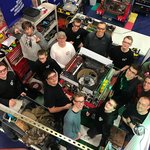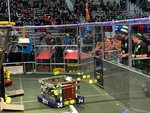


More than 400 teams from across the world met in Houston last week for FIRST Robotics Competition championship.
Among them were the CloverBots of Battle Ground.
The CloverBots finished as a division semi-finalist, but the real accomplishment was making it there, given the unique nature of their team makeup compared with the hundreds of other teams who joined them and the thousands of others that didn’t make it.
While most teams feature somewhere between 60 to 70 players, the CloverBots have between 15 and 20. Furthermore, other teams are generally based out of, and funded by, a school district. The CloverBots, however, are a 4-H club, made up of mostly CAM Academy and home-school students from around the Battle Ground area, with the exception of a few outliers from around Clark County.
FIRST Robotics Competition is an international robotics competition for high school age students. Together with mentors and coaches, youths build a 120-game-playing robot in six weeks, which then competes against other teams and their robots.
Recent years have seen FIRST Robotics competitions grow more popular around the world. Just this year, the championships were expanded to two locations, Houston and St. Louis, with the top finishers of both meeting in the finals.
Battle Ground’s small group of roboticists were able to qualify for Worlds by accumulating a sizable amount of qualification points at those various competitions.
The decisive chunk of points that catapulted them to Houston came in March at their district championship, where they finished 12th out of over 150 teams in the Pacific Northwest.
Lauren Choquer, a junior at CAM Academy and Running Start student at Clark College, describes the competitions as a game of strategy, as opposed to the battling bots one might see on TV.
Each team forms an alliance with two other teams before a competition, based on the region they’re from.
Then, the teams’ pilots guide their robots through a series of tasks to win points.
During one task, the robot serves as a delivery vehicle between team members stationed outside a small arena and a designated teammate at a station, called an airship, at the center of the area. A team member loads a gear onto the bot and then the pilot navigates it to the station where a waiting team member retrieves it and secures it to a rotor on the station.
Each rotor requires a particular number of gears to get it spinning, and once it does, points are awarded to that team.
The CloverBots had the highest “rotor engagement points,” or, most gears placed, of the more than 400 teams competing last weekend.
With a team only one-third the size of most others, every member of the CloverBots wear multiple hats. Choquer, for example, is student lead on electronics and team president.
This is Choquer’s first year, and she admits she didn’t know the difference between a screw and a bolt before joining the team. But the intense six-week building process taught her to learn quickly by asking questions often.
“It’s even more rewarding for us to see our robot do well and go to worlds because we’re so small and have such little funding,” she said.
Once her role on the Colverbots comes to an end, she plans on going into biomedical engineering.
The veteran of the team is Mackinnon Buck.
A senior at CAM Academy, Buck is in his fourth year on the team and is the lead programmer. He drives the robot at competitions.
Buck’s main interest is in programming. He started programming when he was 12, and working with robotics was a natural evolution for him.
He talked about how “incredible” it is to see all the moving parts — literally and figuratively — come together over such a short period of time, and how seeing positive results from their small team’s hard work is what has kept him interested over the last four years.
Buck hopes to use those four years of experience to help launch a career in software development.
Brenda Johnson is the 4-H leader and head coach for all the First Robotics competition teams, which ranges from high school-aged CloverBots to the Legolandians, ages 5 to 8, who learn basic engineering concepts with Legos.
Johnson worked with electronics during her time in the Navy before a teaching career and was inspired to start a 4-H robotics club when her daughter became interested in Lego robotics.
Now in their eighth year, the CloverBots continue to defy odds with their success under her watch.
“Everyone is a little shocked we do so well, “Johnson laughed.
This is the second time the CloverBots have competed at the world level in seven years.
She talked about how the CloverBots have always been outmatched in resources by powerhouse high schools around the area. The robots of Camas and Skyview, for example, are vibrantly customized and built out of well-equipped school workshops. The CloverBots build their machine in a small backroom of a church.
What they lack in resources, though, has been made up with resourcefulness.
David Buck, engineering manager at HP, mentor for the CloverBots and father to the aforementioned Mackinnon Buck and his brother Everett Buck, the Cloverbot’s pilot, sees the team being small, in many ways, as beneficial to the students. He explained how some youths find themselves on the periphery, as a member of a bigger teams, but every CloverBot plays an important role in the team’s success.
“It gives an opportunity for every kid to really contribute in a meaningful way,” he said.